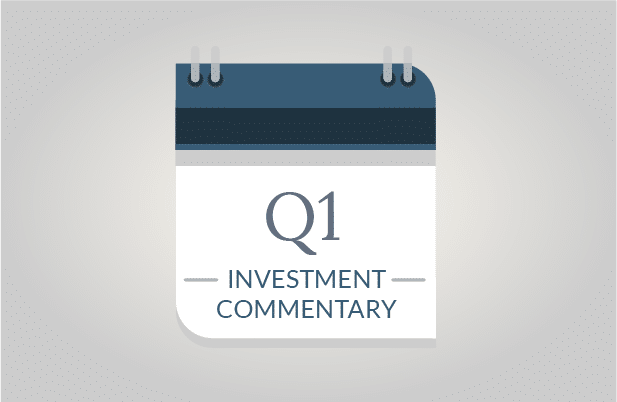- Bonds and stocks enjoyed investment gains during the first quarter of the year.
- Bank defaults shook the markets, but resilience has followed.
- Inflation continued to wane, and the Fed raised rates at a more modest pace.
Welcomed Investment Strength Returns
After an incredibly difficult 2022, the first quarter of 2023 brought welcomed relief as broad investment markets posted positive returns. In fact, investment returns were rather robust considering the short three-month timeframe.
The economy continued to grow while inflation continued to decline. The Fed raised rates, but at a more modest pace. Despite a temporary pullback after isolated bank failures, the markets were rather resilient, bringing prosperity back to investor balance sheets. Furthermore, many areas that were hard hit in 2022 staged strong comebacks, such as technology stocks.
A summary of key investment market returns in the first quarter are as follows:
Bloomberg U.S. Aggregate (U.S. bonds) 2.96%
S&P 500 Index (large U.S. stocks) 7.03%
Nasdaq (largely tech & growth stocks) 17.05%
Russell 2000 (small U.S. stocks) 2.74%
MSCI All Country World Index ex-US 6.87%
(International Stocks)
Banking Sector Troubles
The most significant event of the first quarter occurred in the banking industry with the failures of Silicon Valley Bank (SVB) and Signature Bank (SB), and the rescue of First Republic Bank and Credit Suisse.
Rising interest rates created large losses on bonds owned by banks, putting institutions in financial duress. We realize that there are questions circulating as to whether recent bank events could lead to another 2008 financial crisis. While no one can predict the future, we do offer a few encouraging comments.
- The 2008 crisis was largely due to widescale mortgage loan defaults. We do not see significant loan default risks in the current environment.
- Concentration in start-up and cryptocurrency companies that plagued SVB and SB are rare among large banks.
- Management problems specific to these banks led to failures.
- Most banks hold much greater protection with higher insured deposits.
Beyond the points above, the FDIC recently created the Bank Term Funding Program in mid-March. This is an emergency lending program designed to provide liquidity to U.S. banks. The intention is to help any banks in duress to create an actionable solution plan rather than banks having to sell securities at losses to increase liquidity.
While we are generally optimistic of banking stabilization, we should note that the recent crisis will lead to tightening in the banking industry. This will likely have a ripple effect on loan availability, critical to economic expansion. Additionally, a mild contagion effect has caused large deposit outflows from smaller regional banks into large banks. Such flows are expected to further reduce business loan availability to small businesses that often rely upon regional banks. It will be important to watch smaller banks as well as any impact on lending availability.
Market Resilience
Fortunately, both stocks and bonds have been rather resilient in 2023. It has been encouraging to see strong market participation in the wake of 2022 investment losses, amid recession concerns, and in the midst of a banking crisis.
The investment markets gained meaningful ground early in the year. The S&P 500 index was up 9% before the banking crisis began. Bank collapses shook the markets, and some gains were lost in mid-March. However, most gains were recouped before the month’s end.
It’s essential to remember that the resilience of the markets often surprises investors. Fear can be extremely dangerous if it prompts investors to sell at depressed prices. This can lead to regrets, as we’ve seen time and time again over decades. It’s worth noting how much key market indices have recovered since the depths of last year’s losses.
Stocks reached correction territory, marked by losses of 20% or greater, in 2022. Since then, the S&P 500 has recovered almost 15% from its October 2022 lows through March 31st.
Bonds experienced their worst year in over a century in 2022, causing investors to contemplate guaranteed rates in money markets and CDs as alternatives. While yields on those instruments have been compelling, they haven’t kept up with the recovery in bonds since last October. The aggregate bond index has recovered over 6% in less than 6 months.
Inflation and the Fed
Continuing with positive news, inflation subsided in the first quarter. The most recent CPI report came in at 6%, down from over 9% last year. Inflation is still high, but there’s been a meaningful improvement. Additionally, many recent indicators suggest that inflation could be falling further.
As a reminder, high inflation was the primary challenge for investments in 2022. A contraction in inflation is good news for investors, businesses, and consumers.
Seeing that inflation is improving, the Fed reduced its pace of raising rates in February and March, increasing only a quarter of a percent after raising rates at the quickest pace in history in 2022. The banking crisis likely impacted the Fed’s decision as well, recognizing that higher rates make banking woes more challenging.
Anytime the Fed raises rates, the effects on the economy are not seen until several months later. Hence, recent rate hikes remain somewhat of an experiment to determine how much they will combat inflation, and if the economy can remain resilient. The hope is to obtain a “soft” landing where the economy slows but remains healthy, versus entering a recession.
An Inverted Yield Curve
On the topic of a possible recession, we’ve had an inverted yield curve for quite some time. This occurs when short-term interest rates are higher than longer-term rates, which is an abnormal event. Inverted yield curves are sometimes an indicator of an upcoming recession. While this could be the case, we note that the yield curve could simply be pricing in projected declines in interest rates as inflation continues to fall.
It’s disconcerting how long the yield curve has been inverted, but inverted yield curves don’t always lead to a recession. Additionally, recessions don’t always correlate to investment losses. In fact, sometimes they lead to investment gains as the markets foresee better days ahead. There are linkages between the investment markets and the economy, but they don’t always track each other in performance.
Looking Ahead
We recognize the risks in today’s markets, namely in the banking sector. However, we also recognize the importance of maintaining a disciplined approach that has historically rewarded investors. This has certainly been the case since the depths of the downturn in October 2022.
As always, we encourage you to contact us to discuss your investments and finances. Your financial security and peace of mind are paramount in our advice and decision making.
SageVest Wealth Management




